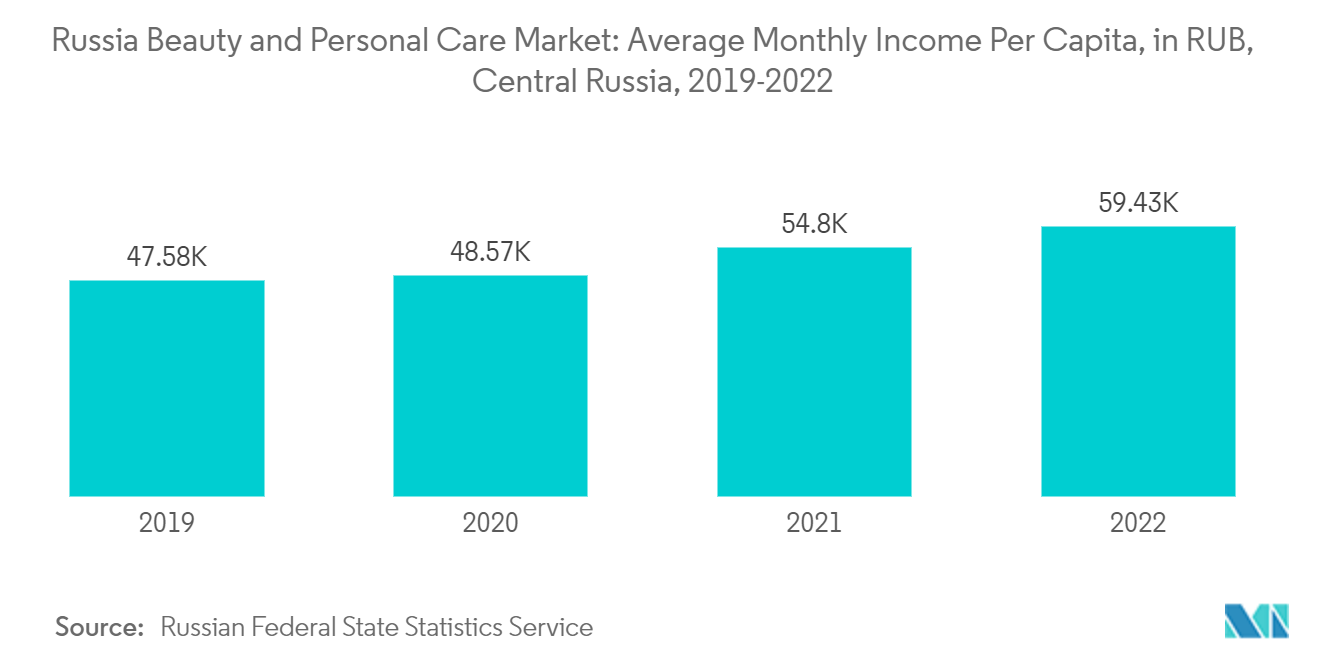Market Trends of Russia Beauty And Personal Care Industry
Rising Demand for Natural/Organic Cosmetics Products
- The popularity boost for natural products containing ingredients such as minerals, proteins, and herbs from traditional Russian medicine has been attributed to numerous factors. These include; the rising GDP per capita (PPP), fall in the unemployment rates, increase in disposable incomes, growing awareness, and rise in the number of distribution channels for organic products. Other factors to aid the forecasted growth include the growing aging female population's demand for anti-aging products, such as moisturizers, creams, and anti-hair loss products.
- Meanwhile, the rising spending power of females aged over 25 is also helping sales. The side effects of chemicals in cosmetic products leading to adverse health outcomes are raising concerns among consumers. Harmful metals and chemicals get absorbed through the skin, accumulate in the body, and lead to ailments such as skin irritation, allergies, and skin dullness, which is inducing consumers to opt for natural products, thereby fueling demand for organic cosmetic products.
- Natural skincare and cosmetic products that are free from chemicals and transparent about the content have been preferred by consumers. This has resulted in a shift in preference from synthetic skincare products to organic products among consumers. To capitalize on this growing interest, the manufacturers in the market have been revamping and expanding their product offerings by introducing a wide range of organic skincare products containing plant-based, clean-label ingredients, with claims such as 'organic,' 'vegan,' 'natural,' 'chemical-free' and 'cruelty-free.' Cosmetic manufacturers are opting for natural and environmental-friendly ingredients to manufacture products.
- The 'green cosmetics' are pushing the need for sustainable beauty products. Manufacturers are taking an interest in sustainable beauty and are using sustainable ingredients in their products. Moreover, consumers are looking for shampoos infused with oils, including blended formulations and pure organics, thus, providing healthy fixes for dry and damaged hair. According to estimates by the European Commission, the production value of shampoo was almost EUR 2.13 billion (USD 2.51 billion) in 2021. Production value grew overall throughout the period under review.

Hair Care Products Shown Significant Growth
- The widespread availability and low cost of hair care products, including shampoo, conditioner, oil, spray, and related items, has resulted in increased expenditure on hair care products across the area. Demand is expected to rise in the coming years as the market responds to an increase in the number of millennials experiencing hair problems like hair loss and dandruff as a result of changing lifestyle habits and rising stress levels among the population of working-class women.
- The purchasing power of the Russian people as a whole, including their ability to spend money on things like hair care products, has increased due to the country's rising per capita income. For instance, according to the World Bank, GDP Per Capita was USD 12,194.8 in 2021, an increase from USD 10,169.1 in 2020.
- Manufacturers are incentivized to provide product innovations, such as new packaging, to meet the rising demand for hair care products as customer tastes evolve, and they spend more of their disposable income on these items. Hair treatment oils, which may be used to stop hair loss, boost shine, and tame frizz, is just one example of the many treatments available in dropper bottles for easy, accurate administration. Companies are responding to the market's need for convenience and portability by producing products in convenient miniature formats such as sachets, deluxe samples, and micro bottles.
- For instance, in March 2021, Procter & Gamble announced the launch of new innovative reusable aluminum bottle packaging for a range of its haircare products. The brands with the new packaging included Pantene, Herbal Essences, and Head & Shoulders. To capitalize on consumers' growing willingness to spend money on hair care products, established businesses are using tactics such as product development, geographic growth, and advertising spending, among others. The players operating in the hair colorants segment are extending their distribution network by adopting direct selling to customers.
- For instance, Estel offers a range of hair colorants in the country, having different variants like non-ammonia hair color and hair dyes having natural ingredients. In response to the growing consumer focus on ingredients, the company asserts that Princess Essex's hair coloring range incorporates key components such as guarana seed extract, beeswax, and a keratin complex. These carefully selected ingredients are believed to enhance the overall quality and appeal of the product, catering to the preferences of discerning consumers..


